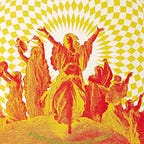Ibero-American Landscapes was a 4 pieces (1 flute 2 guitars and 1 cello) repertoire written by Edwin Guevara Gutiérrez, composer and guitarist. And on April 29th, I was honored to attend to the premier of the repertoire. It was an amazing piece of work. Dissonant, beautiful and extremely rich in form.
We walked in the Crowders Hall before 11:00 AM, while they were on stage tuning their instruments. It seemed like at least half of the class were there in person, it definitely felt good to attend to a live performance with other audiences. Dr Mugmon made an introduction for the four performance, then stepped down from stage to allow them continue their rehearsal. They rehearsed couple segments of the piece, like tapping on guitar and communicate to make sure each part match up. After about 20 minutes, Dr Mugmon went on stage for a short speech while the performers went back stage to get prepared. And the spotlight dimmed, the four performers walked out from behind the curtain one by one as audiences applaud. They started their performance soon after a short sound check for their instruments.
The first thing I noticed was the layers. The music was beautifully layered in mostly counter-melody fashion. At first the cello plucked one of the main melody with a low and punchy sound, laying the fundamental layer. The one guitar came in, playing a counter part against the cello, a melody surrounding the main melody while making changes. Then the second guitar came in, playing a counter part against the first guitar. At last the flute came in, emphasizing the first melody. And this kind of form was carried out throughout different movements/sections. One instrument introduced a melody, then others comes in by playing different melodies that surrounds the main idea, embody the idea and enrich the form.
In most part of the piece, different instruments worked in a counter-melody fashion, but not every part. In many segments of the piece, different instruments team up together to support the other’s parts. For example, there were parts where the two guitars was playing similar chords as a rhythm and fundamentals while the flute and cello singing out the melody. And there were parts where the flute and cello work together creating a smoother fundamental layer for the guitar to run on.
While there were many segments of the piece featuring really pleasuring melodies, there were some parts where it seemed each instruments played dissonantly together beautifully, adds an avant-garde touch to the piece. I personally loved those segments, because they creates tensions, giving audience pressure. After the tension build up, it is usually followed by really pleasant and relaxing parts, which resolves the tension and enhance the pleasure from the smooth sound that comes after. I think this also helps making the piece even more visual. When you are listening you can feel the tension over landscapes. You have mountains, and over the mountains there are rivers and boundless plains. The tensions helps intensify the landscapes differences.
The piece was overall really creative, from the basic idea behind composition to the arrangement. The composer had a quite interesting concept behind the piece, which was to have each performer’s name into the music. At first he laid out all letters, then have each letter match with a number. Then have each note in a chromatic scale match up with the number. Therefore you have letter A=1=C, B=2=C#, C=3=D, etc. Then you can break down each name into letters and translate it into correlating correlating notes. It was with this concept in thought he composed the piece, which I found interesting when I first heard him explaining it in class. Each instruments were also quite creative when it came to making sounds. The flute made some sounds during a part where it sounds just like wind blowing, the guitar was being tapped on as concussions. Other than those, the form of the piece was also creative. Not only there were parts that sounded like a tango, in different sections rhythm also had changes. In one part it had a subtle change from 4/4 to 3/4, which totally changed the way audience grove with the piece.
After the performance, they stood up and bowled to the audience as we strongly applauded. It was such an enjoyment to attend to this premier for me, and I believe also for the other audiences. It was truly an piece of impressive repertoire.
#MUS130B
